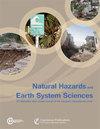应对效能和自我效能在弱势家庭备灾行动中的作用
IF 4.7
2区 地球科学
Q1 GEOSCIENCES, MULTIDISCIPLINARY
引用次数: 0
摘要
摘要应对效能感和自我效能感对备灾的影响已被广泛报道。然而,大多数研究只是笼统地证明了它们与备灾的关系,而没有确定它们是否也会对不同的弱势家庭(即照顾老年人和/或残疾成人(COD)、照顾儿童(CC)和低能力(LC))的备灾产生不同的影响。在本研究中,备灾分为两个因变量:充分备灾和最低备灾。研究利用 2021 年全国住户调查中抽取的 4559 个样本进行了定量分析,以调查应对效能和自我效能与弱势家庭所采取的备灾措施之间的关系。二元逻辑回归结果表明,弱势群体家庭一般更有可能报告较低的备灾水平。应对效能对 LC 和 COD 家庭更为重要,而自我效能对 LC 和 CC 家庭更为重要。根据这些研究结果,可以针对不同的家庭类型采取相应的干预措施,帮助弱势家庭更好地做好备灾准备。本文章由计算机程序翻译,如有差异,请以英文原文为准。
The role of response efficacy and self-efficacy in disaster preparedness actions for vulnerable households
Abstract. The effects of response efficacy and self-efficacy on disaster preparedness have been widely reported. However, most studies only prove their relationship to disaster preparedness in general terms without ascertaining whether they also variously impact the disaster preparedness of diverse vulnerable families (i.e., caring for older and/or disabled adults (COD), caring for a child (CC), and low capacity (LC)). In this study, disaster preparedness is divided into two dependent variables: adequate and minimal preparedness. A quantitative analysis was conducted using 4559 samples drawn from the 2021 National Household Survey to investigate the relationship between response efficacy and self-efficacy with preparedness measures adopted by vulnerable households. Binary logistic regression results indicated that households with vulnerable groups are generally more likely to report lower disaster preparedness. Response efficacy is more critical to LC and COD families, while self-efficacy is more important to LC and CC families. Based on these findings, interventions can be tailored to suit different family types and help vulnerable families better prepare for disasters.
求助全文
通过发布文献求助,成功后即可免费获取论文全文。
去求助
来源期刊
CiteScore
7.60
自引率
6.50%
发文量
192
审稿时长
3.8 months
期刊介绍:
Natural Hazards and Earth System Sciences (NHESS) is an interdisciplinary and international journal dedicated to the public discussion and open-access publication of high-quality studies and original research on natural hazards and their consequences. Embracing a holistic Earth system science approach, NHESS serves a wide and diverse community of research scientists, practitioners, and decision makers concerned with detection of natural hazards, monitoring and modelling, vulnerability and risk assessment, and the design and implementation of mitigation and adaptation strategies, including economical, societal, and educational aspects.

 求助内容:
求助内容: 应助结果提醒方式:
应助结果提醒方式:


